Experimental Characterization of the Engineering Properties of Landfill Compost-Biocover
Abstract
:1. Introduction
2. Materials and Methods
2.1. Materials Used
2.2. Methods Employed
2.2.1. Chemo-Biological Tests
2.2.2. Moisture Density Relationship Tests
2.2.3. Relative Diffusion Coefficient
2.2.4. Hydraulic Conductivity Tests
2.2.5. Thermal Tests
3. Results and Discussions
3.1. Chemo-Biological Characteristics
3.2. Moisture and Density Relationships
3.3. Hydraulic Behavior of Compost Material
3.4. Thermal Behavior of Compost Materials
4. Conclusions
Author Contributions
Funding
Data Availability Statement
Acknowledgments
Conflicts of Interest
Appendix A

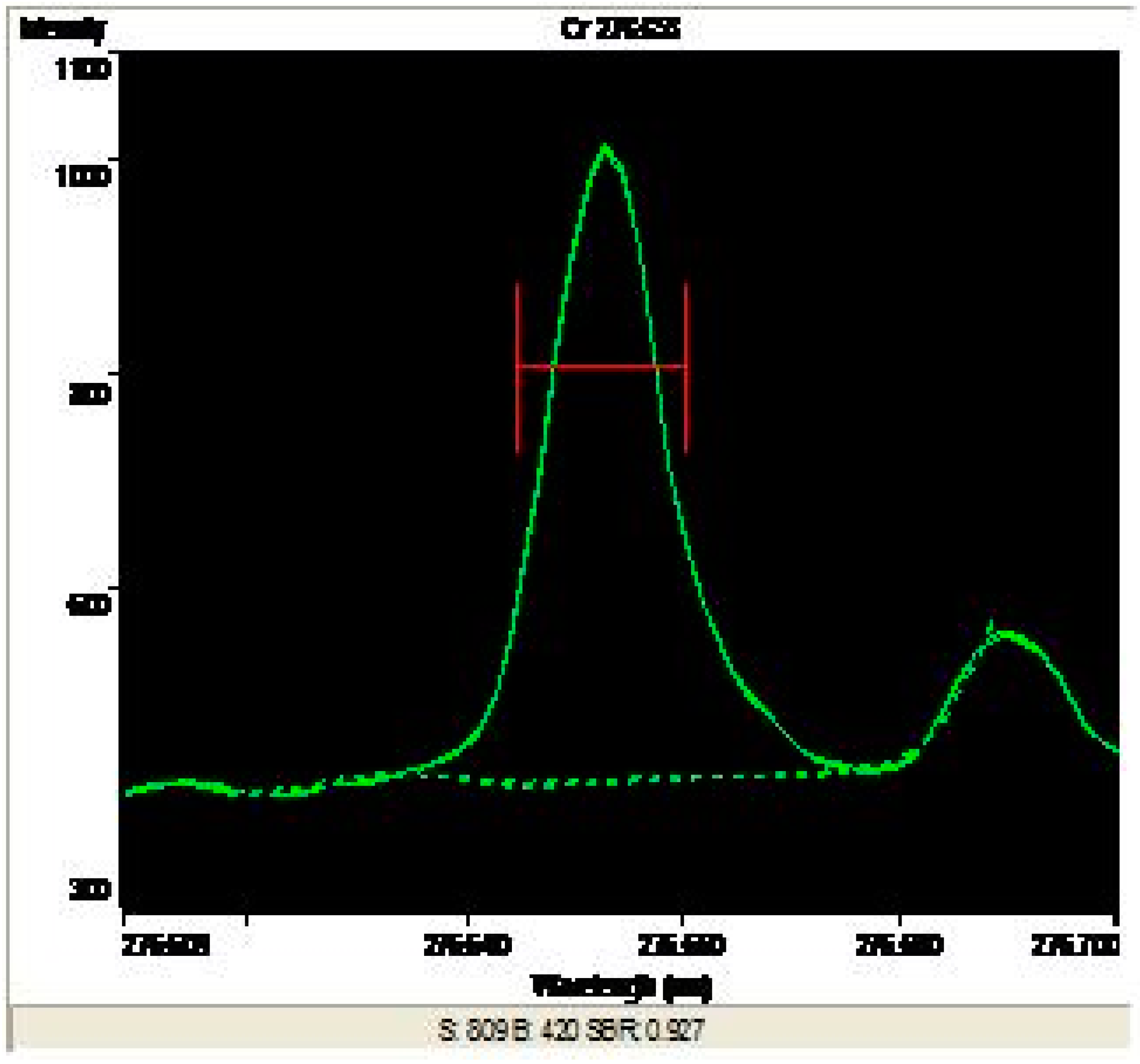
References
- Bajar, S.; Sing, A.; Kaushik, C.P.; Kaushik, A. Suitability assessment of dumpsite biocover to reduce methane emissions from landfills under the interactive influence of nutrients. Environ. Sci. Pollut. Res. 2021, 28, 1519–1532. [Google Scholar] [CrossRef] [PubMed]
- Parsaeifard, N.; Sattler, M.; Nasirian, N.; Chen, V.C.P. Enhancing anaerobic oxidation of methane in municipal solid waste landfill cover soil. Waste Manag. 2020, 1, 44–54. [Google Scholar] [CrossRef] [PubMed]
- Khoshand, A.; Fall, M. Geotechnical characterization of compost-based biocover materials 2014. Geotech. Geol. Eng. 2014, 32, 489–503. [Google Scholar] [CrossRef]
- Yuan, L. Methane Emission and Oxidation through Landfill Covers. Ph.D. Thesis, College of Engineering, Florida State University, Tallahassee, FL, USA, 2006. [Google Scholar]
- Reddy, K.R.; Yargicoglu, E.N.; Chetri, J.K. Effects of biochar on methane oxidation and properties of landfill cover soil: Long term column incubation tests. J. Environ. Eng. 2021, 147, 04020144. [Google Scholar] [CrossRef]
- Phillips, D. Ambient air quality synergies with a 2050 carbon neutrality pathway in South Korea. Climate 2022, 10, 1. [Google Scholar] [CrossRef]
- IPCC. Climate Change 2007: Synthesis Report. Contribution of Working Groups I, II and III to the Fourth Assessment Report of the Intergovernmental Panel on Climate Change; Core Writing Team, Pachauri, R.K., Reisinger, A., Eds.; IPCC: Geneva, Switzerland, 2007; 104p. [Google Scholar]
- IPCC. Climate Change 2014: Synthesis Report. Contribution of Working Groups I, II and III to the Fifth Assessment Report of the Intergovernmental Panel on Climate Change; Core Writing Team, Pachauri, R.K., Meyer, L.A., Eds.; IPCC: Geneva, Switzerland, 2014; 151p. [Google Scholar]
- Pokhrel, D. Compost-Based Biocap Performance. Ph.D. Thesis, Department of Civil Engineering, University of Calgary, Calgary, AB, Canada, 2006; pp. 1–290. [Google Scholar]
- Huber-Humer, M.H.; Gebret, J.; Hilger, H. Biotic systems to mitigate landfill methane emissions. Waste Manag. Res. 2008, 26, 33–46. [Google Scholar] [CrossRef]
- Ait-Benichou, S.; Jugnia, L.B.; Greer, C.W.; Cabrel, A.R. Methanotrophs and methanotrophic activity in engineered landfill biocovers. Waste Manag. 2009, 29, 2509–2517. [Google Scholar] [CrossRef]
- Abichou, T.; Mahieu, K.; Yuan, L.; Chanton, J.; Hater, G. Effects of compost biocovers on gas flow and CH4 oxidation in a landfill cover. Waste Manag. 2009, 29, 1595–1601. [Google Scholar] [CrossRef]
- Huber-Humer, M.; Roder, S.; Lechner, P. Approaches to assess biocover performance on landfills. Waste Manag. 2009, 29, 2092–2104. [Google Scholar] [CrossRef]
- Scheutz, C.; Kjeldsen, P.; Bogner, J.E.; Visscher, A.D.; Gebert, J.; Hilger, H.A.; Huber-Humer, M.; Spokas, K. Microbial methane oxidation process and technologies for mitigation of landfill gas emissions. Waste Manag. Res. 2009, 27, 409–455. [Google Scholar]
- Tanthachoon, N.; Cheimchaisri, W. Alternative approach for encouraging methane oxidation in compost-based landfill cover layer with vegetation. In Proceedings of the International Conference on Sustainable Solid Waste Management, Chennai, India, 5–7 September 2007; pp. 202–209. [Google Scholar]
- Majdinasab, A.; Yuan, Q. performance of the biotic systems for reducing methane emissions from landfill sites: A review. Ecol. Eng. 2017, 104, 116–130. [Google Scholar] [CrossRef]
- Albana, M.; Fernandes, L. Effects of temperature, moisture content, and fertilizer addition on biological methane oxidation in landfill cover soils. Toxic Radioact. Waste Manag. 2009, 13, 187–195. [Google Scholar] [CrossRef]
- Visvanathan, C.; Pokhrel, D.; Cheimchaisri, W.; Hettiaratchi, J.P.A.; Wu, J.S. Methanotrophic activities in tropical landfill cover soils: Effects of temperature, moisture content and methane concentration. Waste Manag. Res. 1999, 17, 1313–1323. [Google Scholar] [CrossRef]
- Maanoja, S.T.; Rintala, J.A. Evaluation of methods for enhancing methane oxidation via increased soil air capacity and nutrient content in simulated soil cover. Waste Manag. 2018, 82, 82–92. [Google Scholar] [CrossRef] [PubMed]
- Diaz, L.F.; Savage, G.M.; Golueke, C.G. Composting of municipal solid wastes. In Handbook of Solid Waste Management, 2nd ed.; The McGraw Hill Companies Inc.: New York, NY, USA, 2002; ISBN 9780071356237. [Google Scholar]
- Haug, R.T. Compost Engineering, Principles and Practice; Ann Arbor Science Publishing Inc.: Detroit, MI, USA, 1980. [Google Scholar]
- Tim, R. The Practical Handbook of Compost Engineering; Taylor & Francis Inc.: Boca Raton, FL, USA, 1993. [Google Scholar]
- Hettiarachchi, J.P.A.; Hettiaratchi, A.; Mehrotra, A. Comprehensive one-dimensional mathematical model for heat, gas and moisture transport in methane biofilters. Waste Manag. 2007, 11, 225–234. [Google Scholar] [CrossRef]
- Pokhrel, D.; Hettiaratchi, P.; Kumar, S. Methane diffusion coefficient in compost and soil—Compost mixtures in gas phase biofilter. Chem. Eng. J. 2011, 169, 200–206. [Google Scholar] [CrossRef]
- Benson, C.H.; Othman, M.A. Hydraulic and mechanical characteristics of compacted municipal solid waste compost. Waste Manag. Res. 1993, 11, 127–142. [Google Scholar] [CrossRef]
- Cabrel, A.R.; Burnotte, F.; Lefebvre, G. Geotechnical characterization of a pulp and paper (deinking) residue used in cover systems. Environ. Geotech. 2002, 1, 207–212. [Google Scholar]
- Cabrel, A.R.; Capanema, M.A.; Gebert, J.; Moreira, J.F.; Jugnia, L.B. Quantifying microbial methane oxidation efficiencies in two experimental landfill bio covers using stable isotopes. Water Air Soil Pollut. 2010, 209, 157–172. [Google Scholar] [CrossRef]
- Chanton, J.P.; Lipay, K. Seasonal variation in methane oxidation in a landfill cover soil as determined by an in-situ isotope technique. Glob. Biogeochem Cycles 2000, 14, 51–60. [Google Scholar] [CrossRef]
- Tan, K.H. Environmental Soil Science, 3rd ed.; Taylor and Francis Group: Boca Raton, FL, USA, 2009. [Google Scholar]
- Chandrakanthi, M.A.; Mehrotra, A.K.; Hettiaratchi, J.P.A. Thermal conductivity of leaf compost used in biofilters: An experimental and theoretical investigation. Environ. Pollut. 2005, 136, 167–174. [Google Scholar] [CrossRef] [PubMed]
- Abu-Hamdeh, N.H. Thermal properties of soil as affected by density and water content. Bio-Syst. Eng. 2003, 86, 97–102. [Google Scholar] [CrossRef]
- Shimizu, N. Process optimization of the composting system, In Robotics and Mechatronics for Agriculture; CRC Press: Boca Raton, FL, USA, 2017. [Google Scholar]
- ASTM D 2974-07a; Standard Test Methods for Moisture, Ash, and Organic Matter of Peat and Other Organic Soils. ASTM International: West Conshohocken, PA, USA, 2007.
- ASTM D 698-07; Standard Test Methods for Laboratory Compaction Characteristics of Soil Using Standard Effort. ASTM International: West Conshohocken, PA, USA, 2007.
- Penman, H.L. Gas and vapor movement in soil: The diffusion of vapors through porous solids. J. Agric. Sci. 1940, 30, 437–462. [Google Scholar] [CrossRef]
- ASTM D5084-03; Standard Test Methods for Measurement of Hydraulic Conductivity of Saturated Porous Materials Using a Flexible Wall Permeameter. ASTM International: West Conshohocken, PA, USA, 2003.
- Célestin, J.C.; Fall, M. Thermal conductivity of cemented paste backfill materials and factors affecting it. Int. J. Min. Reclam. Environ. 2009, 274–290. [Google Scholar] [CrossRef]
- Agnew, J.M.; Leonard, J.J. The physical properties of compost. Compost Sci. Util. 2003, 11, 238–264. [Google Scholar] [CrossRef]
- Puppala, A.J.; Pokala, S.P.; Intharasombat, N.; Williammee, R. Effects of organic matter on physical strength, and volume change properties of compost amended expansive clay. J. Geotech. Geoenviron. Eng. 2007, 133, 1449–1461. [Google Scholar] [CrossRef]
- Gonzalez, J.L.; Medina, M.; Benitez, I.C. Slurry composting options. BioCycle 1989, 30, 53–55. [Google Scholar]
- Wallach, R.; Da Silva, F.F.; Chen, Y. Unsaturated hydraulic characteristics of composted agricultural waste, tuff, and their mixtures. Soil Sci. 1992, 153, 434–441. [Google Scholar] [CrossRef]
- Lambe, T.W. The structure of compacted clay. J. Soil Mech. Found. Div. 1958, 84, 1–34. [Google Scholar] [CrossRef]
- Mitchell, J.K.; Soga, K. Fundamentals of Soil Behavior; John Wiley & Sons Inc.: Hoboken, NJ, USA, 2005. [Google Scholar]
- Seed, H.B.; Chen, C.K. Structure and strength characteristics of compacted clays. J. Soil Mech. Found. Div. 1959, 85, 87–128. [Google Scholar] [CrossRef]
- Daniel, D.E. Landfill Impoundments. In Geotechnical Practice for Waste Disposal; Springer: New York, NY, USA, 1993; pp. 97–112. [Google Scholar]
- Kamon, M.; Inazumi, S.; Inui, T. Durability of compacted sludge landfill over-under wetting drying cycle. Environ. Geotech. 2002, 1, 661–666. [Google Scholar]
- Li, Z.; Yu, X. Multi physical simulation of freezing unsaturated soil. Geotech. Spec. Publ. 2010, 199, 157–166. [Google Scholar]
- Tang, A.M.; Cui, Y.J. Determining the thermal conductivity of compacted MX80 clay. In Unsaturated Soil; American Society of Civil Engineers: Reston, VA, USA, 2006; pp. 1695–1706. [Google Scholar]
- Cote, J.; Konrad, J.M. A generalized thermal conductivity model for soils and construction materials. Can. Geotech. J. 2005, 42, 443–458. [Google Scholar] [CrossRef]
- Ramires, M.L.V.; Neito de Castro, C.A.; Nagasaka, Y.; Nagashima, A.; Assael, M.J.; Wakeham, W.A. Standard reference data for the thermal conductivity of water. J. Phys. Chem. Ref. Data 1995, 24, 1377–1381. [Google Scholar] [CrossRef]
- Al Nakashabandia, G.; Kohnke, H. Thermal conductivity and diffusivity of soils as related to moisture tension and other physical properties. Agric. Meteorol. 1964, 2, 271–279. [Google Scholar] [CrossRef]
- Hettiarachchi, V.C. Mass, Heat and Moisture Transport in Methane Biofilters. Ph.D. Thesis, University of Calgary, Calgary, AB, Canada, 2005. [Google Scholar]
- Mor, S.; De Visscher, A.; Ravindra, K.; Dahiya, R.P.; Chandra, A.; Van Cleemput, O. Induction of enhanced methane oxidation in compost: Temperature and moisture response. Waste Manag. 2006, 26, 381–388. [Google Scholar] [CrossRef] [Green Version]
- Cosenza, P.; Guerin, R.; Tabbagh, A. Relationship between thermal conductivity and water content of soils using numerical modelling. Eur. J. Soil Sci. 2003, 54, 581–587. [Google Scholar] [CrossRef]
- Mears, D.R.; Singley, M.E.; Ali, G. Thermal and physical properties of compost. In Proceedings of the 7th National Agricultural Waste Management Conference: Energy, Agriculture and Waste Management, Syracuse, NY, USA, 1975; Ann Arbor Science Publishers, Inc.: Detroit, MA, USA; pp. 515–527. [Google Scholar]
- Kodesova, R.; Fer, M.; Neuberger, P. Thermal properties of representative soils of the Czech Republic. Soil Water Resour. 2014, 8, 141–150. [Google Scholar] [CrossRef] [Green Version]
- Ahn, H.K.; Sauer, T.J.; Richard, T.L.; Glanville, T.D. Determination of thermal properties of composting bulk materials. Biosci. Technol. 2009, 100, 3974–3981. [Google Scholar] [CrossRef]
- Fredlund, D.G.; Rahardjo, H. Phase Properties and Relationships, In Soil Mechanics for Unsaturated Soils; John Wiley & Sons, Inc.: New York, NY, USA, 1993. [Google Scholar]
- Bajwa, T.; Fall, M. Coupled thermal-hydraulic and mechanical (THM) evolution of compost materials in the column. In Proceedings of the 66th Canadian Geotechnical Conference and the 11th Joint CGS/IAH-CNC Groundwater Conference, GeoMontreal, Montréal, QC, Canada, 29 September–3 October 2013. [Google Scholar]
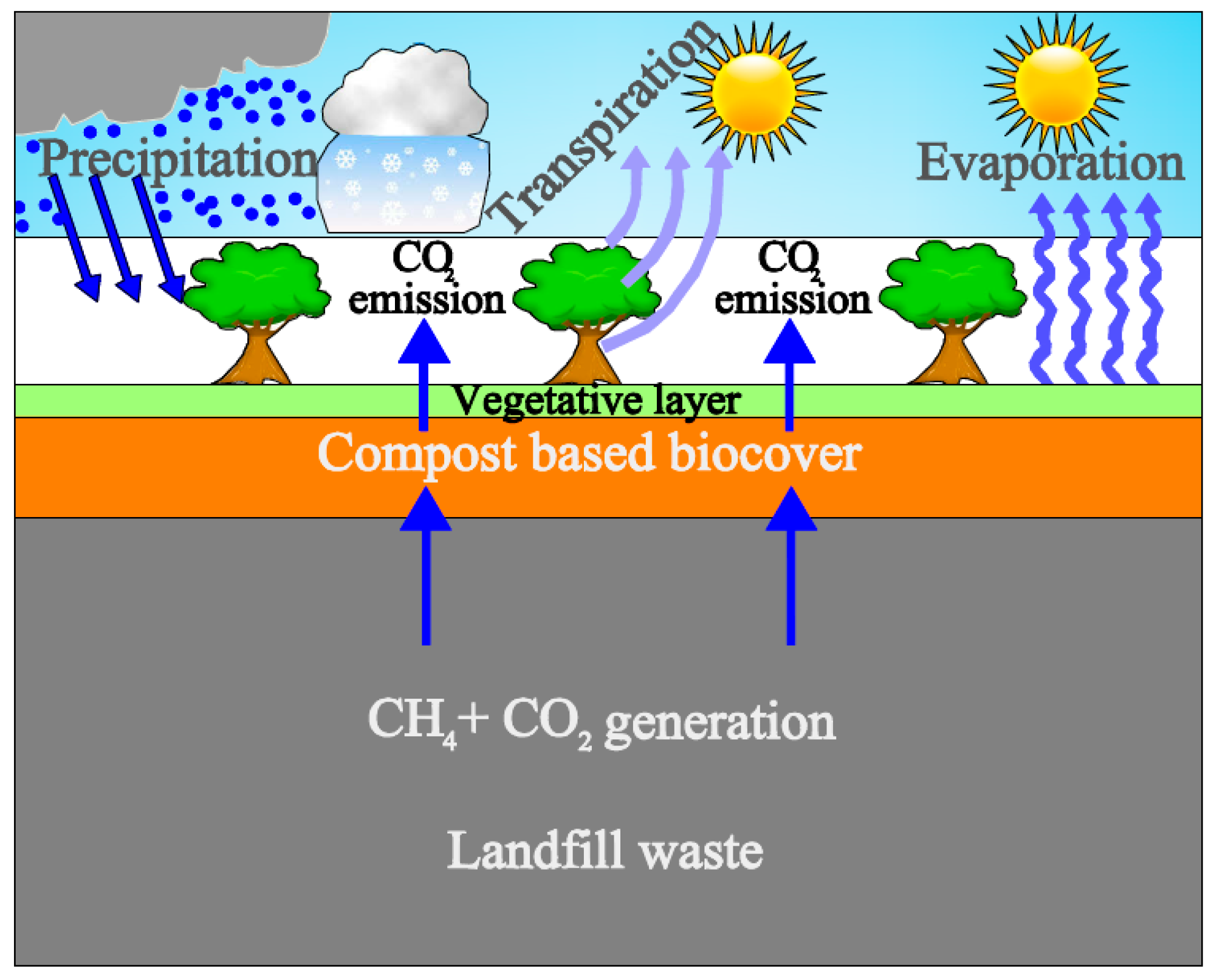
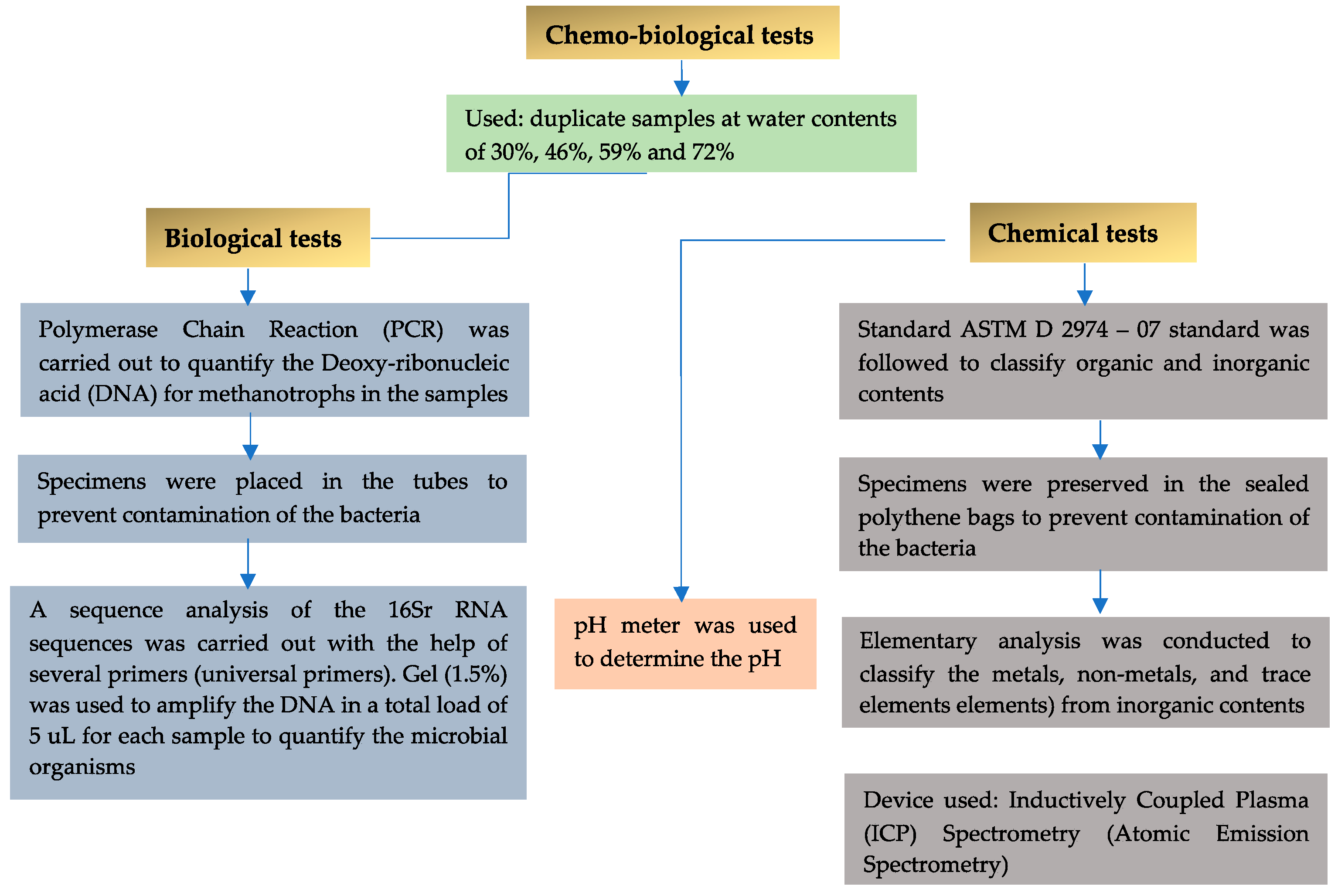
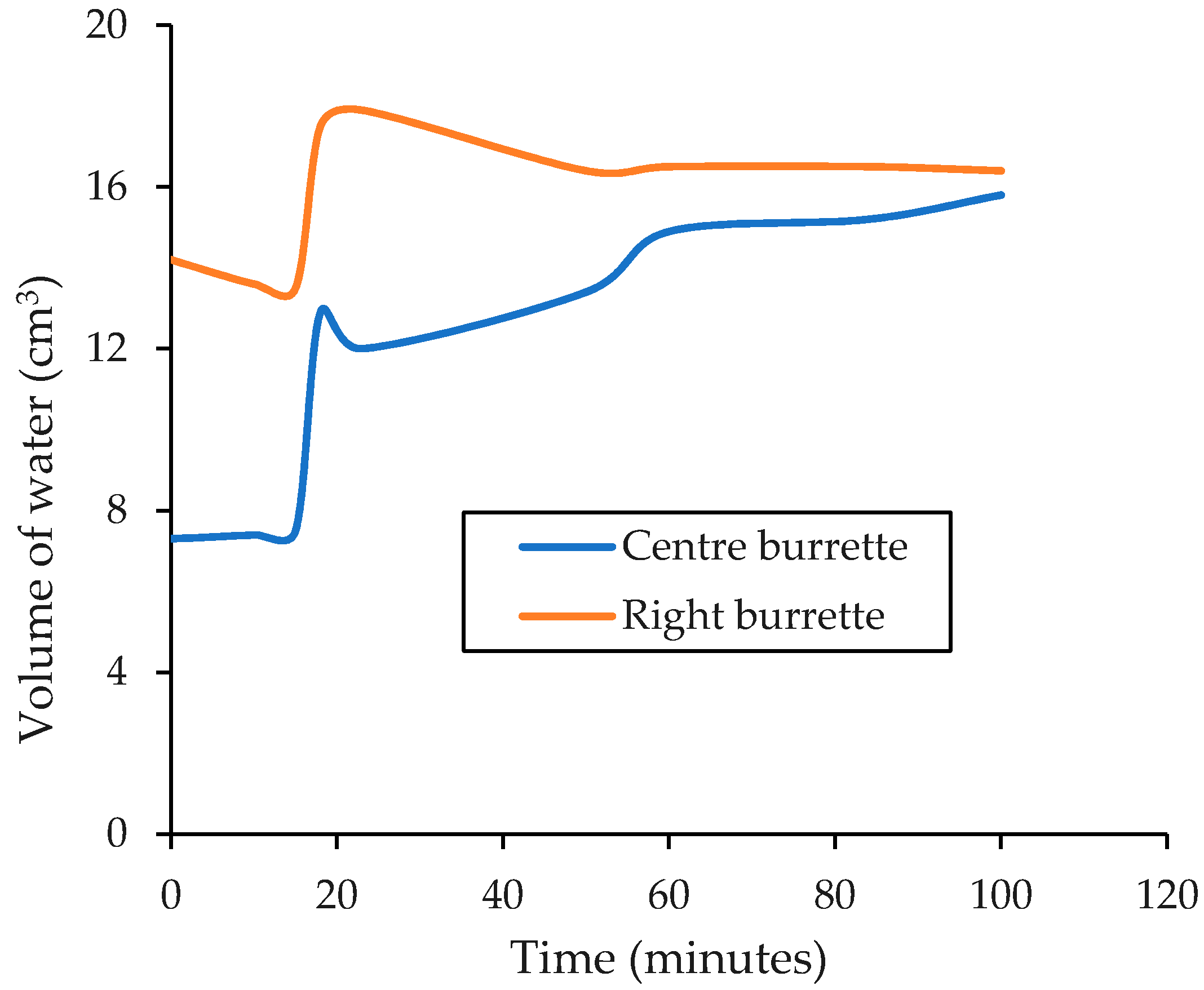

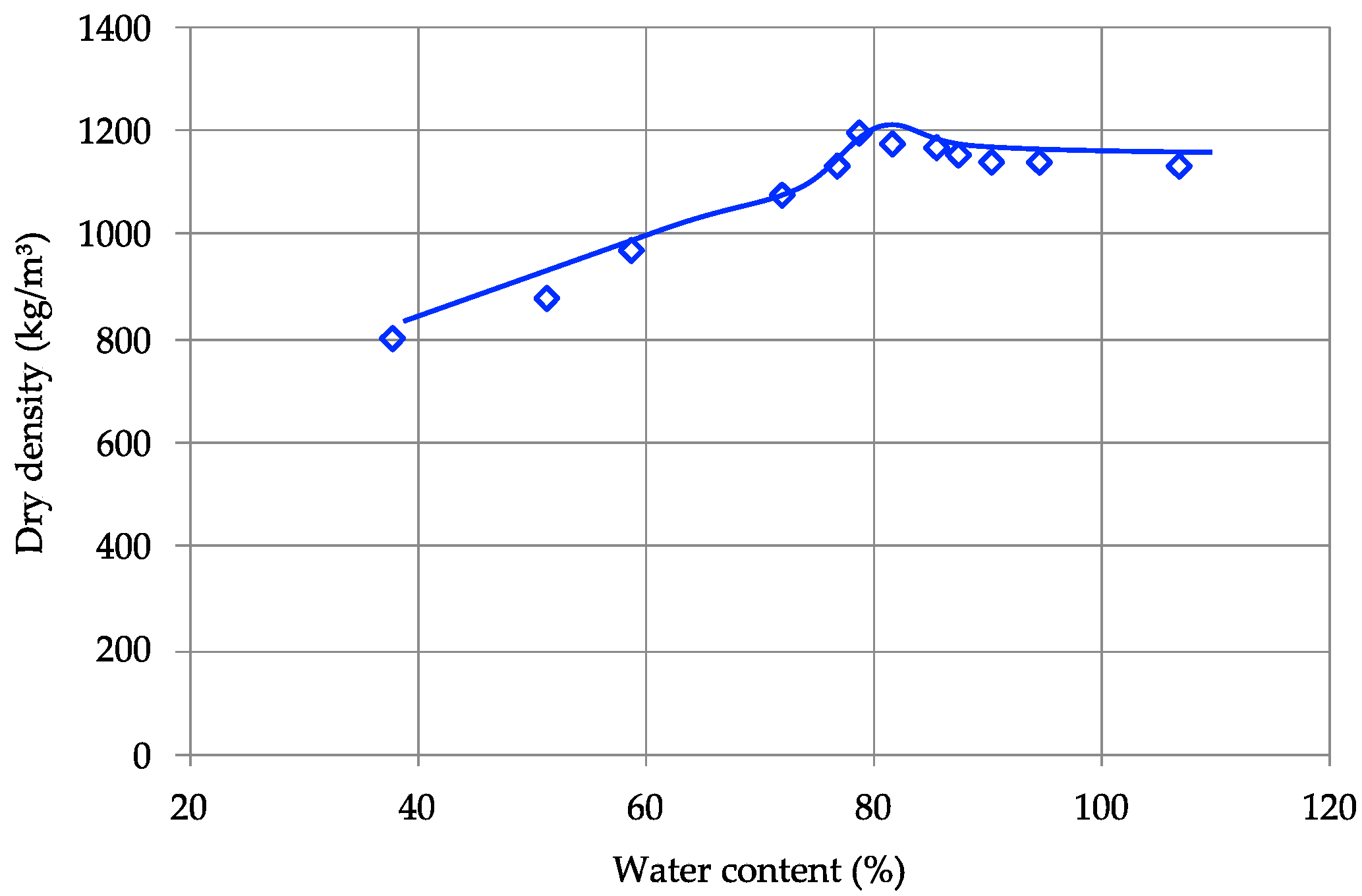
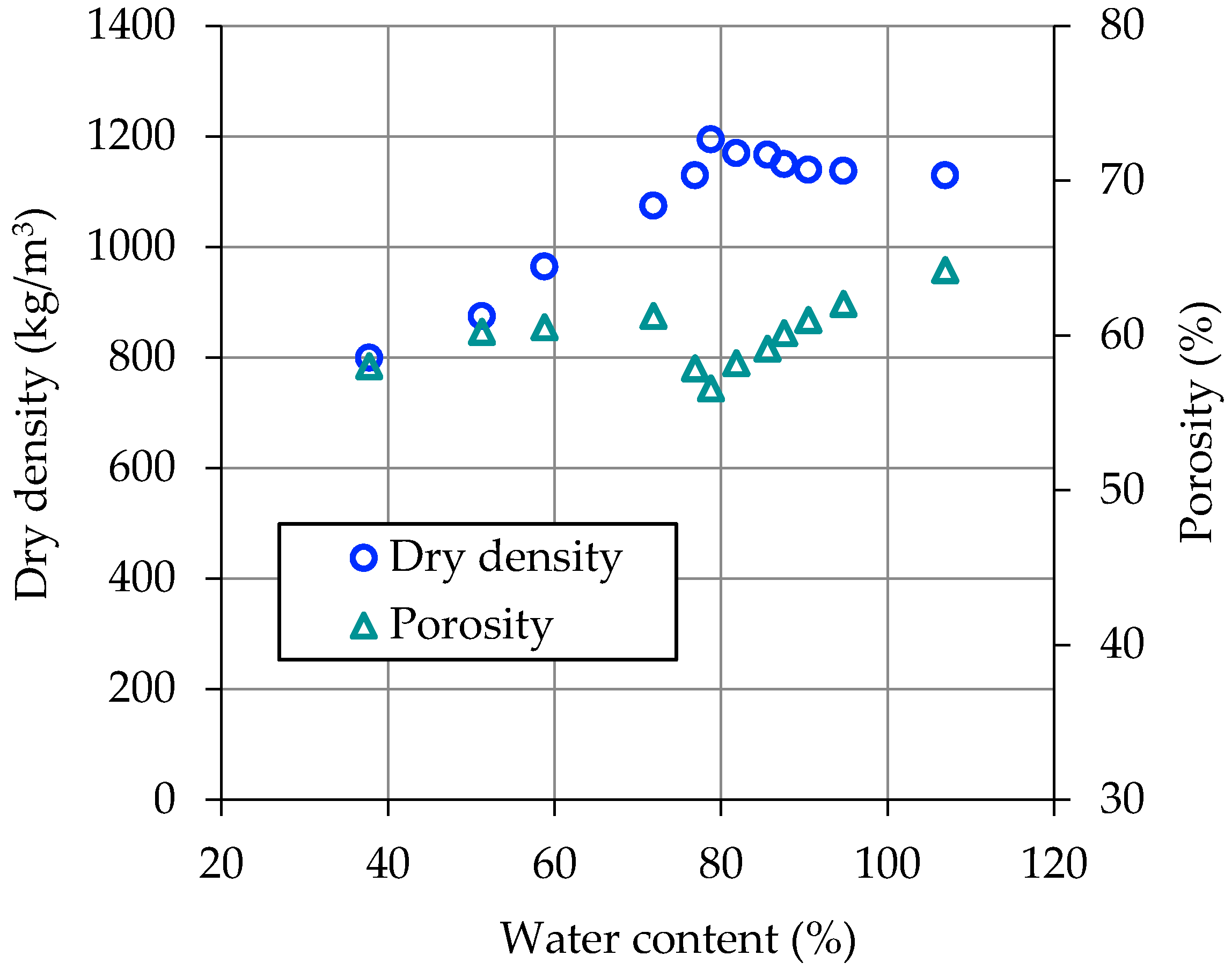





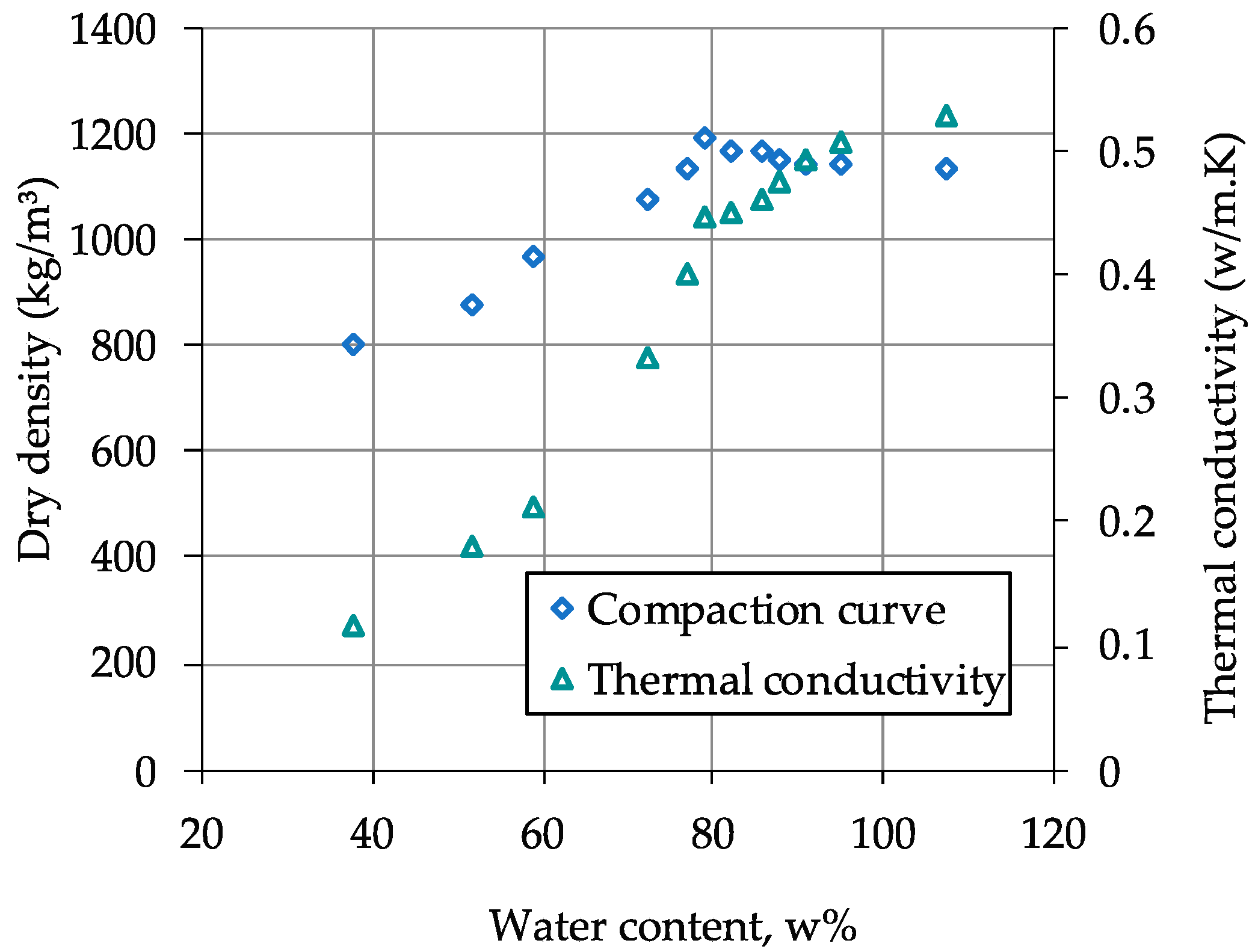
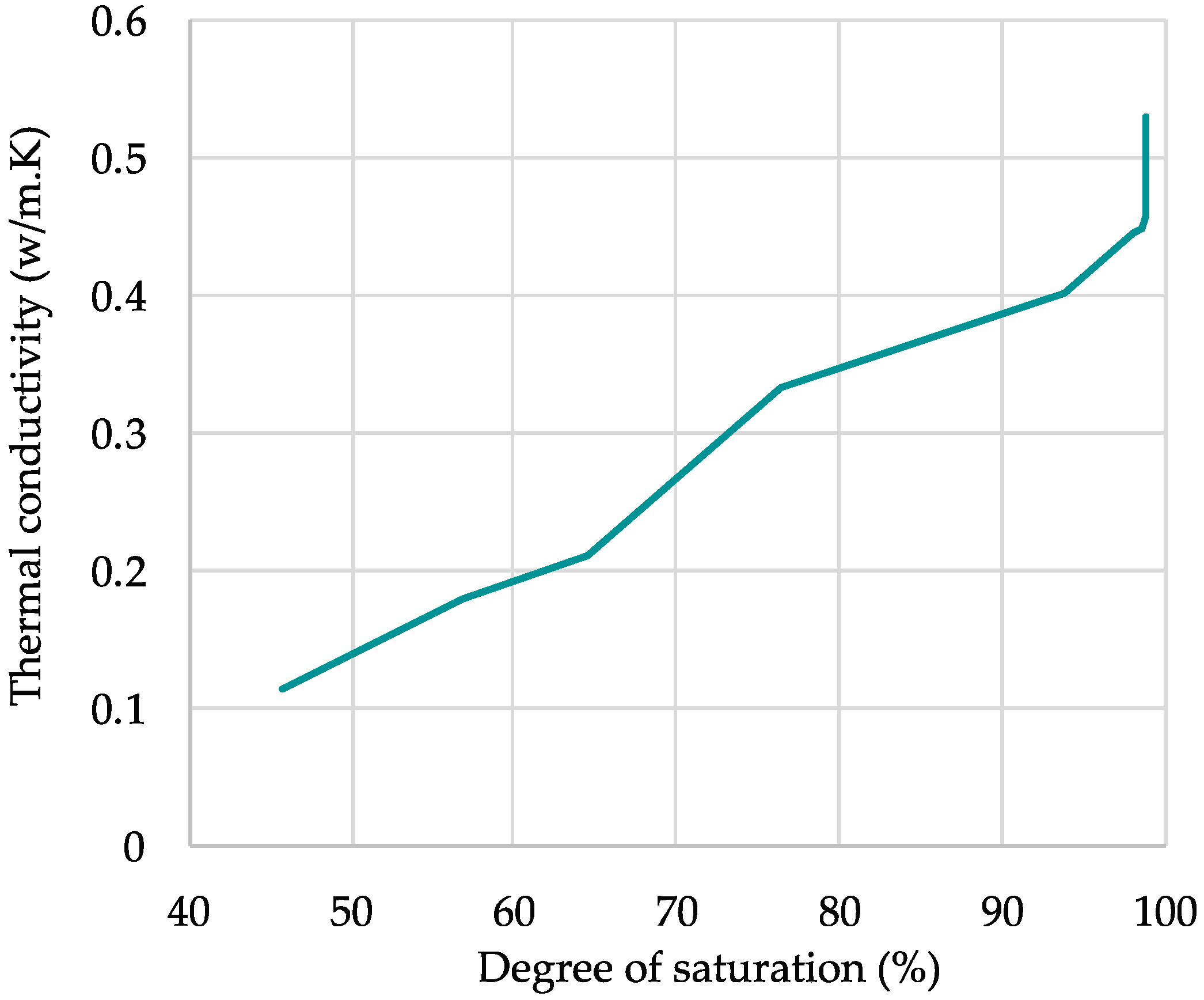
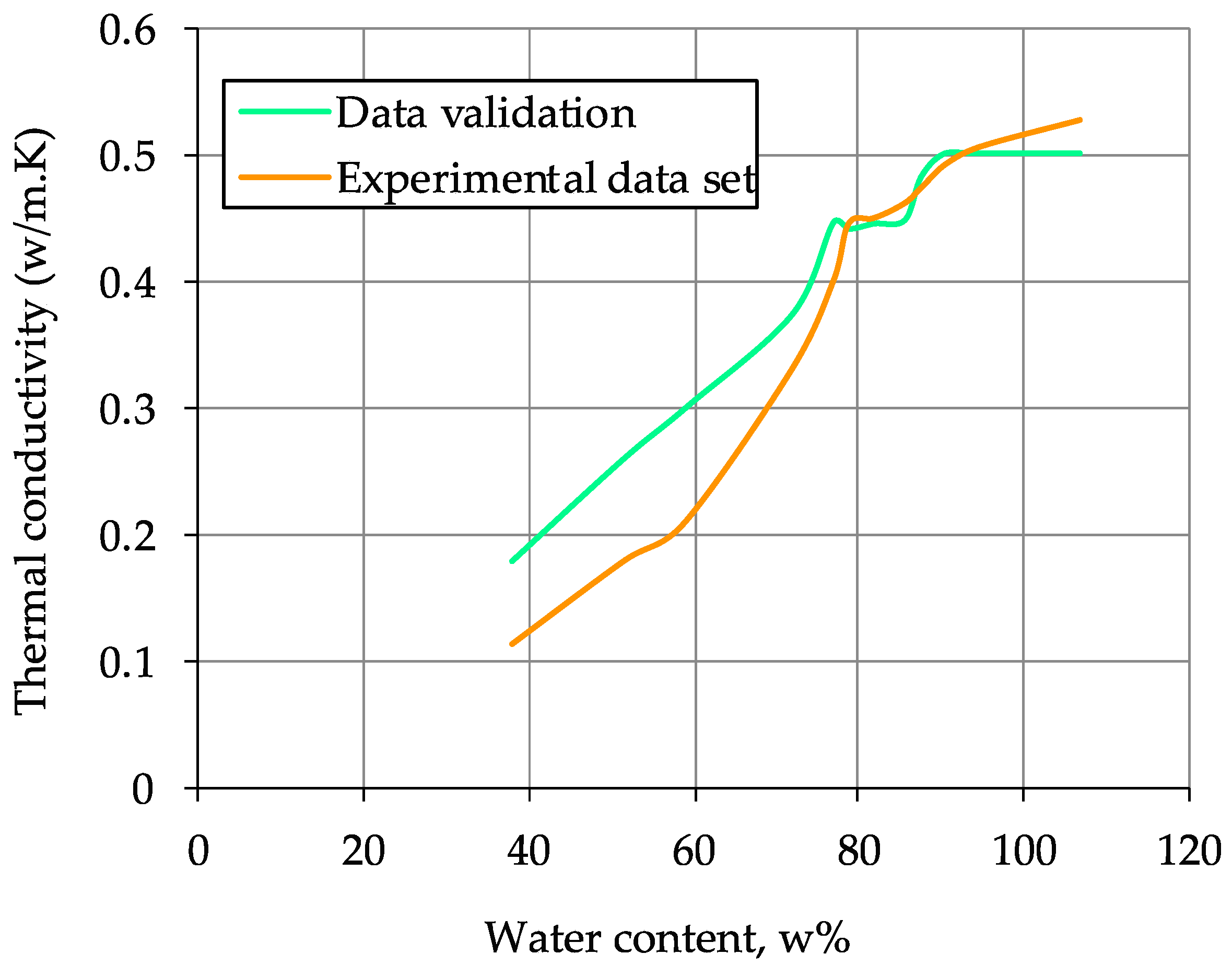
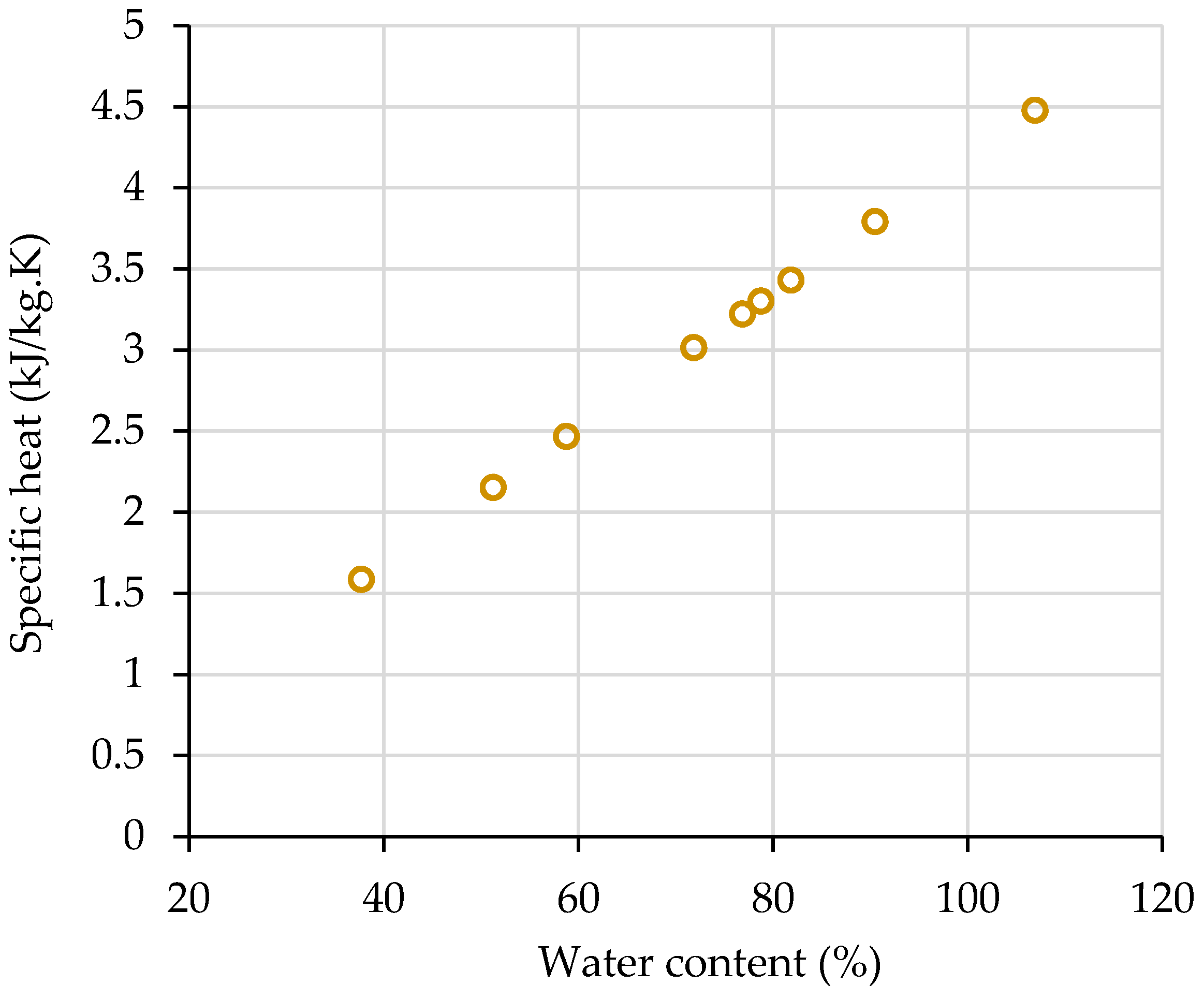

Publisher’s Note: MDPI stays neutral with regard to jurisdictional claims in published maps and institutional affiliations. |
© 2022 by the authors. Licensee MDPI, Basel, Switzerland. This article is an open access article distributed under the terms and conditions of the Creative Commons Attribution (CC BY) license (https://creativecommons.org/licenses/by/4.0/).
Share and Cite
Bajwa, T.M.; Fall, M.; Alshawmar, F. Experimental Characterization of the Engineering Properties of Landfill Compost-Biocover. Appl. Sci. 2022, 12, 4276. https://doi.org/10.3390/app12094276
Bajwa TM, Fall M, Alshawmar F. Experimental Characterization of the Engineering Properties of Landfill Compost-Biocover. Applied Sciences. 2022; 12(9):4276. https://doi.org/10.3390/app12094276
Chicago/Turabian StyleBajwa, Tariq M., Mamadou Fall, and Fahad Alshawmar. 2022. "Experimental Characterization of the Engineering Properties of Landfill Compost-Biocover" Applied Sciences 12, no. 9: 4276. https://doi.org/10.3390/app12094276





